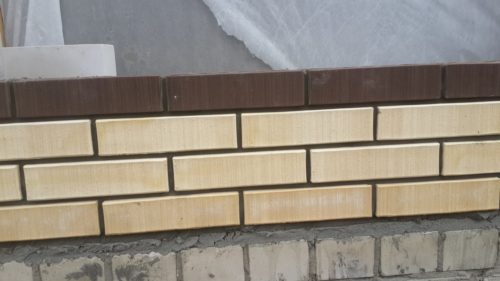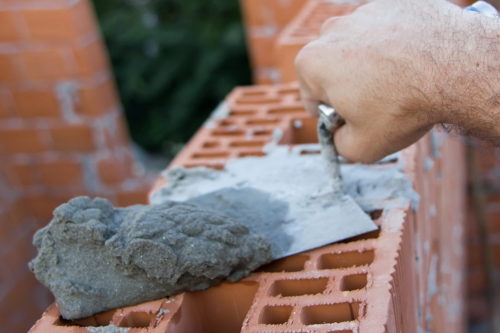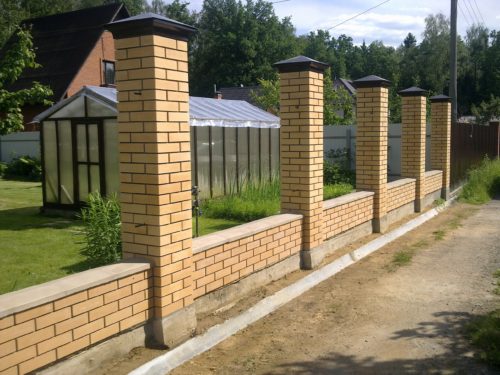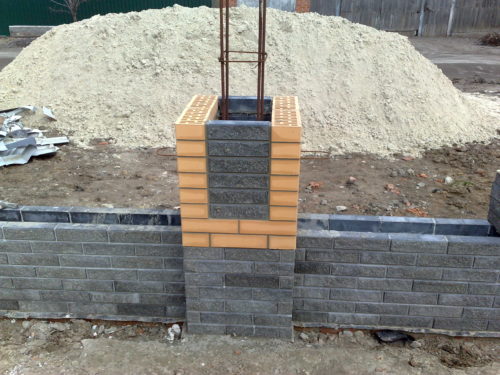Fences erected on the basis of brick or stone are often destroyed or simply lose their initial strength. Such a situation arises if there are external factors that can harm building structures. Unlike houses, fences are damaged much easier, and often restore the fence becomes not so simple.
Content
Also, the fence may be a victim of non-compliance with technology during its construction. At first glance, the problem may not be too significant, but in fact, the fence begins to collapse in the eyes.
In this article, we will look at the main features of the repair of a stone or brick fence, relying exclusively for their strength.
Repair of a brick or stone fence. State fence
When we talk about repairing the fence, then often all the problems lie precisely at the base of the design. Therefore, it turns out that after winter frosts, when the snow begins to melting, the state of the foundation deteriorates sharply. The design seats, is exhausted either shifted. Basic errors when creating foundation are as follows:
- The features of the soil. During preliminary work on the creation of a foundation, the soil characteristics did not take place. Obviously, the soil can have a wide variety of indicators that can affect the fence in different ways.
- Shallow fundamental depth. It also happens that for some reason, the base is too close to the surface of the soil, so at the slightest external influences the position of the fence will be broken.
- No reinforcement. Without reinforcement, no durable concrete design is now not produced. In the case of a fence, we have not too serious factors that can damage the design without reinforcement, but there are different situations.
- Problems with drainage. The builders know perfectly well that high-quality drainage can save any construction design from problems when water begins to accumulate in large volumes, thereby worsening the characteristics of concrete and other components of the fence.
Most often, the above problems are manifested in the form of cracks on the fence, therefore even a visual inspection of the structure can allow you to determine the problem at an early stage and immediately start acting. If the fence is in a deplorable state, and some element is already tilted above the ground, you can face difficulties associated with the fact that it will not work out.
It is possible to slightly extend the life of the fence by depulting the concrete mix or using piles, but it is hardly possible to get a full-fledged result, and there will be no fences at best.
Repair of a brick or stone fence. Cracks in the fence
Cracks or chips appearing on the fence mean that there is a serious threat to the destruction of the fence, so if you do not take action on time, then the design can be completely unusable.
- First of all, you need to arm the construction level, with which you can determine if there are any deviations in the design. At the same time, you need to quickly close the crack by alabaster or cement.
- Experts recommend regularly inspecting the fence, and when even the most miniature cracks are found right there, as literally in a short period of time, the crack can grow into full destruction of the fence.
- On cracks and similar damage to brick or stone fences, moisture and plants are significantly affected, which are actively expanding all these parts.
The process requires the following tools:
- hammer;
- chisel;
- trowel;
- metal brush.
There will also be no excess water installation, with which, under large pressure, cracks will be cleaned.
Works are performed in the following order:
- It is necessary to arm a chisel and expand with its help existing cracks. Part of the material with such manipulations will be folded, after which it all needs to be deleted.
- With a metal brush, it is necessary to clean the crack so that there is no dirt, no residues of the source material.
- Now you need to remove dust and any traces of work with the installation with high water pressure. The plot should be pure for the final stage.
- Well, at the very end we need to take a cement solution and fill them all the cracks. It is necessary to ensure that there is no emptiness, therefore it is necessary to compact the mixture.
Cracks on brickwork
If the cracks in concrete are a common phenomenon, then the situation is somewhat more complicated with bricks. Causes of cracks There is a considerable amount:
- Negative exposure to the Sun, moisture, as well as low temperatures.
- Bad or missing waterproofing base.
- The specificity of the foundation.
- Combining various types of bricks or cement mixture.
- The type of brick is not suitable for building work of this kind.
In the case of the last two points, the situation can be corrected only radically by dismantling the bricks and making the laying of new rows. For the rest, you can use some recommendations.
Tools and devices:
- hammer;
- chisel;
- metal brush;
- perforator;
- trowel;
- syringe for pumping the solution.
Thus, the preparatory process consists of the following steps:
- With the help of a construction level and a plumb, all existing deviations are determined.
- As in the past case, with the help of chisel, all cracks expand, and then high-quality cleaning and flushing with water occurs.
- Now the time comes to fill all the shallow cracks with a solution. To do this, you do not need to use any specific settings, as a last resort, the material can be used simply by hand. These manipulations are carried out only for large cracks.
- If the crack is deep, but narrow, you can arm a perforator and using the appropriate drill to expand the object, after which it is possible to fill with a solution.
- In the event that the material has a crack more than 20 mm on any of the sides, it is best to simply replace brick to a new one, as this is the easiest option to get high repair quality.
- Ultimately, a metal profile stripes may be required to be attached around the perimeter of a brick design with anchors or bolts. Such a decision will be the most correct if there are long cracks.
Basic Stage:
- Deep cracks are cleaned (up to 20 mm deep), which are also pre-cleaned and washed with water. If the cracks are already too deep, it is easier not to close every recess, but simply replace one or another brick.
- All laying should be well moistened with water so that you can make at least small changes in the design. Maintaining moisture masonry must be constantly until the repair process continues.
- Well, the most responsible step is to fill the seams with a solution. As in the past cases, it is necessary to monitor the solution of the solution, since the presence of voids in the material means that no effect will bring repair either make it only worse. It is enough to compact the material with the help of a primary means - it is not fundamentally.
- At the very end there is a removal of surplus solution. It should be prevented that the material is dry, otherwise then remove the residues will be extremely difficult. The removal of excess should be made using a brush or a damp cloth.
Repair of a brick or stone fence. Support poles of fence
Often, the fencing poles become the most important part of the design. They take on the main loads, and also create a single construction enclosing building.
In the case of a brick fence, this material performs a decorative role, while metal reference pillars are the main design. However, there are pillars created from the brick, then such a decision is often not the most thoughtful, since the brick is significantly more expensive than the metal pipe, as well as a less reliable option.
Metal pillar does not create any problems, but the brick support is either concrete, are often covered by cracks, and immediately need to act.
If the cracks are too large, the only correct solution is the use of a metal pipe, which is embedded inside the support part. The pipe must be broken in the ground by about 60 cm. If this condition is observed, then such a support must withstand large loads, while maintaining an attractive appearance of the fence.
If the process of dismissing the design of the fence or overhaul is too difficult, it makes sense to pay attention to the following recommendations:
- Replacing bricks. If the situation is not too dangerous, and the cracks appeared only on several bricks, they can be easily replaced, thereby returning the design of the initial state. However, there is a difficult task here to remove bricks that are not in the best condition.
- As we said, small cracks mean that the process of destruction is still at the initial stage. All this can be sealed with cement mortar, but it must be remembered that if cracks appear on many bricks, you need to take more decisive actions.
- If the overall state of the support post leaves much to be desired, you need to remember that the use of metal corners can be used to be a good option, at least temporary. It is about creating a frame that would hold all the support, thereby even with large damage to bricks will remain in place. As a permanent option to ensure reliability of supports, it is also a good solution.
Repair of a brick or stone fence. Destruction of foundation
The foundation becomes the cause of damage to the fence regularly. Most often, the problem lies in the fact that the base of the fence was created with errors.
- In addition, the lack of deepening foundation may also be an acute problem. At first glance, builders may think that a certain depth is enough, and various external conditions indicate the opposite. Approximately the same situation and the width of the base.
- If a concrete mixture was used when pouring, which, unfortunately, has not the best proportions of the components, the design can quickly come into disrepair.
- Well, often it happens that people have a minimum of experience in construction, so during the fill, employees can quickly go to the next stage of work, without waiting for the complete hardening of the design.
Therefore, in the event of the destruction of the fence due to the foundation, the following activities should be held:
- At the very beginning, you need to stop the fence on the side with which the slope of the fence occurs. For this case, concrete column columns, wood bars, etc. come true.
- Next, you need to undermine the foundation in such a way that there is a trench, and immediately install the backup. It is advisable to use P-shaped pile elements (they are welded on the basis of a chapeller), which will create a reliable base for the fence.
In the event that the design still begins to deform or just fall, no repair work will no longer help, you need to completely dismantle the design and all create it again. Probably, the problem in the specifics of the soil or design features, which was used initially.
The usual pile foundation is used within the framework of problem areas where the soil significantly affects the current situation on the site. However, the problem is that if the plot is large, then the installation of piles is not the simplest task. It makes sense to analyze possible options for foundations, and after that make a choice.
Dimensions of the fence and bases must have a certain ratio. It is too small compared to a fear of the fence. If a massive fence, then the base should be the same.























